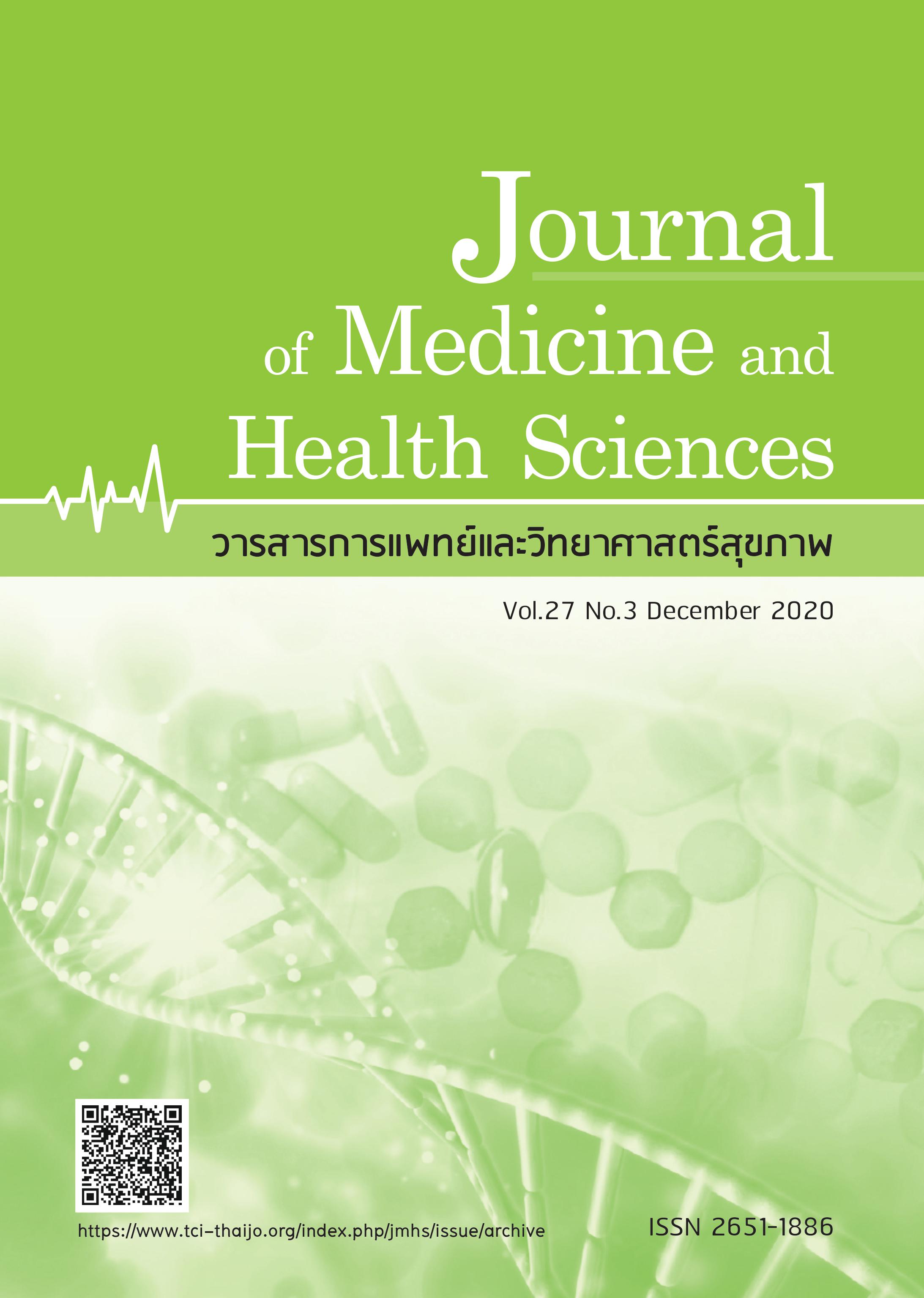Endotracheal suctioning guideline of intubated adults
Keywords:
suctioning, guideline, endotracheal tube, adultsAbstract
Abstract
Endotracheal suctioning is an essential nursing activity to provide adult patient with sufficient oxygen supply and prevent airway obstruction. However, the inefficient endotracheal suctioning may lead to complications. The objective of this article was to review the endotracheal suctioning practice guideline for nurses or health care providers in order to understand and can apply it appropriately for each and every individual practice context. According to the article review, the endotracheal suctioning practice guideline was divided into 3 phases. 1) Pre-suctioning phase comprised of nursing assessment of clinical indications, providing information for the patients and relatives, positioning before suctioning, using sterile technique, selection of the suction catheter, and supplying oxygen. 2) Suctioning phase comprised of suctioning in the mouth before suctioning in the endotracheal tube, the appropriate pressure level, the depth of suction catheter, the duration and the frequency of suctioning, and supplying high concentration oxygen. 3) Post-suctioning phase comprised of supplying oxygen after suctioning, management of used medical appliance, and the evaluation of the patient after suctioning. In each phase of suctioning, nurses or health care providers can apply these practices appropriately with individual practice context in order to provide safe and efficient endotracheal suctioning for intubated adult patient to prevent the complications.
References
2. Thapsongsang P, Yodrak W, Hirunchunha S. Endotracheal suctioning in patients with severe traumatic brain injury. Songklanagarind J Nurs 2018;38(3):192-97.
3. Pinto HJ, D'silva F, Sanil TS. Knowledge and practices of endotracheal suctioning amongst nursing professionals: a systematic review. Indian J Crit Care Med 2020;24(1):23–32.
4. American Association for Respiratory Care (AARC). Endotracheal suctioning of mechanically ventilated patients with artificial airways 2010. Resp Care 2010;55(6):758-64.
5. Chaseling W, Bayliss SL, Rose K, et al. Suctioning an adult ICU patient with an artificial airway: a clinical practice guideline. [Internet] 2014 [cited 2020 July 8] Available from
https://www.aci.health.nsw.gov.au/__data/assets/pdf_file/0010/239554/ACI14_Suction_2-2.pdf.
6. Khimani R, Ali F, Rattani S, et al. Practices of tracheal suctioning technique among health care professionals: literature review. Int J Nurs Educ 2015;7(1):179-83.
7. Galbiati G, Paola C. Effects of open and closed endotracheal suctioning on intracranial pressure and cerebral perfusion pressure in adult patients with severe brain injury: a literature review. J Neurosci Nurs 2015;47(4):239-46.
8. Hu J, Yu L, Jiang L, et al. Developing a guideline for endotracheal suctioning of adults with artificial airways in the perianesthesia setting in China. J Perianesth Nurs 2019;34(1):160-8.e4.
9. Hlinková E, Nemcová J, Bielená K. Closed versus open suction system of the airways in the prevention of infection in ventilated patients. Cent Eur J Nurs Midw 2014;5(2):63-71.
10. Elmansoury A, Said H. Closed suction system versus open suction. Egypt J Chest Dis Tuberc 2017;66(3):509-15.
11. Aryani DF, Tanner J. Does open or closed endotracheal suction affect the incidence of ventilator associated pneumonia in the intensive care unit? A systematic review. Enferm Clin 2018;28(Suppl 1):325-31.
12. Ardehali SH, Fatemi A, Rezaei SF, et al. The effects of open and closed suction methods on occurrence of ventilator associated pneumonia: a comparative study. Arch Acad Emerg Med 2020;8(1):e8.
13. Thomas P, Baldwin C, Bissett B, et al. Physiotherapy management for COVID-19 in the acute hospital setting: clinical practice recommendations. J Physiother 2020;66:73-82.
14. Ayhan H, Tastan S, Iyigun E, et al. Normal saline instillation before endotracheal suctioning: “What does the evidence say? What do the nurses think?”: multimethod study. J Crit Care 2015;30(4):762-67.
15. Wang CH, Tsai JC, Chen SF, et al. Normal saline instillation before suctioning: a meta-analysis of randomized controlled trials. Aust Crit Care 2016;30:260-65.
16. Jansson M, Ala-Kokko T, Ylipalosaari P, et al. Evaluation of endotracheal suctioning practices of
critical care nurses: an observational correlation study. J Nurs Educ Pract 2013;3(7):99-105.
17. Maraş GB, Güler EK, Eşer İ, et al. Knowledge and practice of intensive care nurses for endotracheal suctioning in a teaching hospital in western Turkey. Intensive Crit Care Nurs 2017;39:45-54.
18. Mwakanyanga ET, Masika GM, Tarimo EAM. Intensive care nurses' knowledge and practice on endotracheal suctioning of the intubated patient: a quantitative cross-sectional observational study. PLOS ONE 2018;13(8):e0201743.
19. Özden D, Görgülü RS. Development of standard practice guidelines for open and closed system suctioning. J Clin Nurs 2012;21(9-10):1327-38.
20. Chiaranai C, Petchprapai N, Chularee S, et al. Closed suction system in patients with artificial airway: a review of empirical evidence. JBCNS 2018;8(1):82-93.
21. Sole ML, Bennett M, Ashworth S. Clinical indicators for endotracheal suctioning in adult patients receiving mechanical ventilation. Am J Crit Care 2015;24(4):318-25.
22. Aramrom Y. Evidence-based practices in prevention of the ventilator-associated pneumonia (VAP). SCNJ 2015;2(3):144-58.
23. Klompas M, Branson R, Eichenwald EC, et al. Strategies to prevent ventilator-associated pneumonia in acute care hospitals: 2014 update. Infect Control Hosp Epidemiol 2014;35(S2):S133-S54.
24. Russian CJ, Gonzales JF, Henry NR. Suction catheter size: an assessment and comparison of 3 different calculation methods. Resp Care 2014;59(1):32-8.
25. Bunburaphong T. Respiratory care in clinical practice. 6th ed. Bangkok: Panyamit Printing; 2016.
26. Hallett S, Toro F, Ashurst JV. Physiology, tidal volume. [Internet] 2020 [cited 2020 November 30] Available from: https://www.ncbi.nlm.nih.gov/books/NBK482502/
27. Linnane MP, Caruana LR, Tronstad O, et al. A comparison of the effects of manual hyperinflation and ventilator hyperinflation on restoring end-expiratory lung volume after endotracheal suctioning: a pilot physiologic study. J Crit Care 2019;49:77-83.
28. Khezri HD, Zeydi AE, Firouzian A, et al. The importance of oral hygiene in prevention of ventilator-associated pneumonia (VAP): a literature review. Int J Caring Sci 2014;7(1):12-23.
29. Harada N. Closed suctioning system: critical analysis for its use. Jpn J Nurs Sci 2010;7:19–28.



